 Even though the primary focus of this blog-site is fan films, the AXANAR infringement lawsuit brought up a lot of interest in the concept of FAIR USE… especially when it comes to unauthorized creation of content based on Star Trek‘s intellectual property.
Even though the primary focus of this blog-site is fan films, the AXANAR infringement lawsuit brought up a lot of interest in the concept of FAIR USE… especially when it comes to unauthorized creation of content based on Star Trek‘s intellectual property.
One such intriguing fair use claim is currently in play in a controversial infringement lawsuit involving Star Trek tribble creator DAVID GERROLD (who used to be the show-runner for Star Trek: New Voyages, so there’s your fan film “connection”). Gerrold and comic book artist TY TEMPLETON raised $30,000 in a Kickstarter to create a “mash-up” of DR. SEUSS and STAR TREK called Oh, The Places You’ll Boldly GO! For more background on this case currently making its way through the Ninth Circuit Federal Court in Los Angeles, read this blog first.
Now, before you get too excited, no, it’s not the “mash-up” lawsuit that just had a major ruling. However, that case will very likely be affected by another ruling that came down from a Federal District Court judge in New York City last month.
In fact, this ruling out of New York could potentially stop the Oh, The Places You’ll Boldly GO! lawsuit dead in its tracks.
Let’s take a look at what just happened…
Up until last month, Dr. Seuss Enterprises (which controls the licensing for the entire Dr. Seuss catalog) had been involved with another lawsuit involving How the Grinch Stole Christmas and little Cindy-Lou Who…who, it seems, is now much more than two!
Our story begins, as you’ll quickly glean, in the year that just passed, 2016. (No, wait. I am NOT going to write this whole blog in rhyme! It’ll take WAY too long, and I don’t have the…um…time. Damn! Must—stop—rhyming!)
Ahem. As I was saying…
Matthew Lombardo, a successful Broadway play-writer, had created a 75-minute one-woman all-rhyming monologue show entitled “Who’s Holiday.” The lone character in the performance was a middle-age Cindy-Lou Who, no longer the little girl who had helped the Grinch’s heart to grow three sizes. In fact, Cindy-Lou Who went on to marry the Grinch after he got her pregnant. Moving into his cave at the top of Mount Crumpit, the couple gradually developed marital problems, and after a domestic scuffle, the Grinch tripped and plummeted to his death. Cindy-Lou was later arrested, tried, and convicted for her husband’s murder. She’s now 45-uyear-olds, living in a trailer park in the hills of Mount Crumpit, drinking heavily, popping pills, and smoking something she calls “who hash.” You know, all the wonderful “happily-ever after” that kids imagine when they read that beloved Christmas story.
 Needless to say, Dr. Seuss Enterprises (DSE) was NOT at all amused. They sent a series of strongly-worded Cease and Desist letters to Mr. Lombardo, who had plunked about $13,000 into the preparation of off-Broadway production at the New World Stages, which was set to open on November 2, 2016. Although the playwright was not actually being sued (yet), it was hard to market the production under the shadow of multiple cease and desist letters. The production was shut down before the show could open.
Needless to say, Dr. Seuss Enterprises (DSE) was NOT at all amused. They sent a series of strongly-worded Cease and Desist letters to Mr. Lombardo, who had plunked about $13,000 into the preparation of off-Broadway production at the New World Stages, which was set to open on November 2, 2016. Although the playwright was not actually being sued (yet), it was hard to market the production under the shadow of multiple cease and desist letters. The production was shut down before the show could open.
In response to the cease and desist letters, Lombardo sued Dr. Seuss Enterprises for two things: 1) the $13,000 he lost because of their interference with his production, and 2) asking the judge to rule that the “Who’s Holiday” play constituted fair use and was therefore protected from any claims of copyright infringement. Dr. Seuss Enterprises filed a Motion to Dismiss and got one of the two things they wanted: the judge threw out the $13,000 in tort interference claims. So no matter what happened, DSE wouldn’t have to pay anything to the playwright.
But the question of fair use was still left open by the judge as a question to resolve. That wasn’t an outcome DSE was at all happy about.
In response to this development, Dr. Seuss Enterprises filed a counterclaim for—you guessed it!—copyright infringement. They also tacked on a few trademark infringement claims, as well. Many of the same arguments were made in this New York lawsuit as have been made in the Star Trek mash-up lawsuit out here in Los Angeles (and I won’t bore you with the details).
The important thing is what happened on September 15…
The judge in the case, Hon. Alvin K. Hellerstein, ruled that “Who’s Holiday” was, in fact, fair use. As such, the copyright infringement claims were immediately dismissed. And for reasons similar to what the judge in the Star Trek mash-up case ruled, the trademark infringement claims were dropped, as well. I invite you to read the full “Who’s Holiday” judgment. (It’s worth it just to read how the judge describes—in detail!—the profanity-laden play on the first few pages of his ruling. It’s pretty amusing.)
In short, Dr. Seuss Enterprises lost and lost big. Their only consolation is they don’t have to pay $13,000 on top of it all. But now the play can be performed free and clear. “There was a cloud of infringement over this play and that’s been lifted,” Mr. Lombardo told The New York Times. “The show goes on.” (Dr. Seuss Enterprises, not surprisingly, is appealing.)
 So what does this have to do with the Star Trek mash-up lawsuit? Glad you asked!
So what does this have to do with the Star Trek mash-up lawsuit? Glad you asked!
On September 18, the defense team for Oh, The Places You’ll Boldly Go! submitted what’s called a Notice of Supplemental Authority in Support of Motion to Dismiss. It includes the full ruling from the New York judge, but more importantly, it points to one critical factor that could help David Gerrold and the mash-up team win their case outright.
Right now, team mash-up is is 3/4 of the way to getting the lawsuit dismissed by proving the work is fair use. The one hold-up is that DSE has told the judge that they do all types of licensing deals, and this mash-up book could deprive them other potential marketing deals.
By law, the judge is required to take DSE at their word when they claim that they will suffer tremendous marketing harm if Oh, The Places You’ll Boldly Go! actually gets published. As such, even though three of the four aspects of fair use come down in favor of “Team Mash-Up,” the fourth—potential harm in the marketplace—is still undecided thanks to the judge having to give DSE the benefit of the doubt when they claim potential financial damages.
But does the judge really have to give DSE the benefit of the doubt? After what just happen in New York, the answer is…perhaps not.
The judge in the “Who’s Holiday” case acknowledged DSE’s claims of market harm:
[DSE] alleges that the Play will cause harm to its licensing market for derivative works and that it has previously authorized a number of Grinch derivative works that expanded on the character of Cindy-Lou Who and included ‘themes and jokes aimed at adult audiences…’
But then the New York judge said this VERY IMPORTANT THING:
[DSE] makes no allegations that it intends to authorize a parody containing references to bestiality, drug use, and other distinctly ‘un-Seussian’ topics” like the play at issue…
And that, my friends, was the final nail in the coffin of the “Who’s Holiday” lawsuit. The judge used that reasoning to rule in favor of fair use.
Team Mash-Up is now using the same argument to try to remove DSE’s last remaining lifeline in trying to rule against fair use. Sure, DSE licenses a lot of things, but they’ve never licensed a mash-up of any kind, nor have they stated any immediate intention to. The mash-up defense attorneys put it this way:
DSE has not alleged that it has licensed, intends to license, or reasonably could license a work like Defendants’ work—a highly transformative mash-up—or any transformative works at all.
If that argument holds and sways the judge in the mash-up case, the lawsuit could be entirely dismissed before the discovery phase ever begins.
 So why are these cases so important that I feel I need to cover them here on Fan Film Factor?
So why are these cases so important that I feel I need to cover them here on Fan Film Factor?
After the ruling invalidating the fair use defense in the Axanar copyright infringement lawsuit, many detractors began mocking the fair use defense as a “scam” intended to protect “thieves” whose crime was the stealing of others’ intellectual property. But there’s a much bigger picture involved in all of this that most of them don’t understand.
Since James Madison began writing the first amendment of Bill of Rights in 1789, the concept of freedom of speech has been proudly enshrined in the very DNA of our great nation. But then there’s also the concept of copyright protection, which encourages people to compose works of art and literature by promising them control of their creations and potential profit from it.
The problem with freedom of speech and copyright protection is that the more that you have of one, the less you have of the other (and vice versa). And that’s why the concept of “fair use” was created in the first place. In fact, fair use actually predates our U.S. Constitution!
In the case of the “Who’s Holiday” play, how far does the Dr. Seuss “empire” stretch? The play is obviously a parody (the judge agreed), and parodies often cannot exist without featuring a fair number of elements from the very thing they are parodying. As for Oh, The Places You’ll Boldly Go! (which was ruled NOT to be a parody), the issue is actually more one of whether to risk setting a legal precedent. As the judge in that case said herself:
This case presents an important question regarding the emerging ‘mash-up’ culture where artists combine two independent works in a new and unique way. … Applying the fair use factors in the manner Plaintiff outlines would almost always preclude a finding of fair use under these circumstances. However, if fair use was not viable in a case such as this, an entire body of highly creative work would be effectively foreclosed.
In other words, this mash-up case could, conceivably, outlaw mash-ups forever. They would become, almost by definition, infringement of at least one, if not two or more, intellectual properties. And perhaps, on a case by case basis, some might indeed cross that line. But does this judge really want this one case to set that precedent?
From her comments above it seems the judge is very reluctant to simply declare Oh, The Places You’ll Boldly Go! an infringing work and potentially cripple countless of potential mash-up works going into the future. She already threw out the trademark infringement claims in the case (although DSE is trying to re-file them), and from reading the tea leaves, she’s been trying really hard to find a way to dismiss the entire case. This New York ruling could give her a convenient precedent to do so.
We’ll likely know soon. The Motion to Dismiss the Amended Complaint was filed by the defense, a Response was submitted by the plaintiffs, and finally a reply to that response came in from the defense…plus submitting this ruling from New York. The next move is the judge’s, where she will rule on the Motion to Dismiss.
If she dismisses the case, then game over, and the mash-up can be completed and published. If the judge allows the case to go forward, then get comfortable…’cause we’re gonna be here for a while.

Damn, if only Axanar had had this judge…
One of the reasons that Winston & Strawn took the case pro bono was that they expected most judges to respond like this judge…especially considering that the 9th Circuit often favors “the little guy” over the big corporate giants.
Erin Ranahan told me at one point that, once they realized they had a hostile judge, the case became much harder for the defense team to win. However, the judge also opened the door to an appeal when he made his ruling invalidating fair use as a defense. That decision brought both sides back to the settlement table, as it crippled Axanar but threatened to keep this case alive and kicking in both the courts and the media for another year or three…and CBS did NOT want that just when Discovery was trying to get off the ground.
Hmm, I thought you said in your earlier blog posts that the option to appeal had no influence on the two sides coming to the table and that the deal was already in its final stages when the shock fair use ruling came out.
Nope. Check again. Although the two sides had conducted settlement discussions earlier in the lawsuit, neither side was willing to give in enough to reach an agreeable mid-point (and yes, I mean both sides). What brought the two sides back to the negotiating table was the fair use ruling. It represented a lose-lose for each side if the case proceeded: Axanar would now likely lose the case (but probably suffer only a small financial penalty for non-willful infringement) while CBS would end up with an embarrassingly tiny victory and an appeal that could drag out for years. There was a pathway to having CBS allow for Axanar to be made, and for CBS, there was a way to reign in what Alec was planning to do significantly. While not a complete in-your-face-obliterate-your-opponent win, it was still a win-win possibility for both sides.
I checked again (just the transcript of your interview with Erin Ranahan), and it reads a bit ambiguously.
You asked “Some (including myself) have hypothesized that Judge Klausner’s summary judgement the first week of January invalidating the “fair use” defense at trial was a game changer for both parties. Is that true?”
and Erin replied “We were working to finalize the settlement for a long time, and it was in the best interests of both sides to do so before trial…”.
According to the transcript of the interview that you posted I didn’t read any confirmation of your hypothesis, her response didn’t start out “Yes, absolutely”, or “Yes, fair use certainly played a part”. She did go on to talk about fair use, but it sounded quite dismissive, it felt like she let you down gently, to paraphrase how I read her response it sounded like Erin said:
“Actually no, this has been in the pipeline for a long time, and if anything else the close proximity to the trial played the largest faction in why the settlement occurred now. Sorry to burst your bubble Jonathan, but even without that, major factor there were also plenty of other smaller factors alongside fair use to consider like summary judgment, the issue of liability and wilfulness would still go before the jury, and the Court also declined to impose injunctive relief, so no, it wasn’t fair use that did it.”
Maybe I have misinterpreted it, but it sounded to me like that was the implication of what Erin said.
Yeah, sorry about that. It’s nearly a year later, and I can’t recall exactly what Erin said to me on and off the record. Whatever appeared on Fan Film Factor while the case was still active and/or immediately after it had settled should be taken as an official statement. Anything else should simply be considered my personal opinion.
No worries, I have a very good long term memory (and a lousy short term memory). And while it doesn’t really matter, I see the first duty of every officer is to the truth. Which reminds me, I just rewatched Below Decks and it surprised me as to how secretive the crew were, that episode did remind me a bit of Disco, and so I wonder how much a change of perspective has on things, going from centre stage, with the captain as the main character, to a position where the lower decks / prisoner becomes the main character.
“Lower Decks” was also more of an exception than a rule.
Did you mean to post the comment on this blog, Jack?
Yes, I did mean to post on this blog post, it was kind of a response to this blog post merged with your previous Disco (vs Axanar) post, they seemed to fuse together, if you can follow the way my brain interconnects stuff ;).
But I don’t know, part of me hopes it was more of an exception, but then I consider our unique position behind the 4th wall as the spider under the table and I wonder how much anyone really knows, following the senior officers into ready room briefings that others would not feel privy to. But anyway I digress way off topic O:).
I am not sure i agree with the ruling that Who’s Holiday was a parody. The story sounds synopses sounds like a bad fanfic that someone is trying to make money off of.
The judge ruled it a parody early on, and I agree. It pokes fun at the original’s “purity” with the most crass and crude tropes of our society today. I don’t say I agree with the concept of “corrupting” little Cindy-Lou Who, but part of the point of parody is you don’t have to agree with it. In fact, many times, it will offend at least someone…often a LOT of someones. 🙂